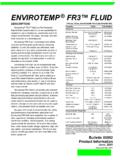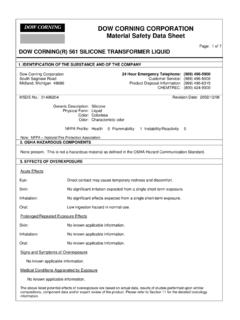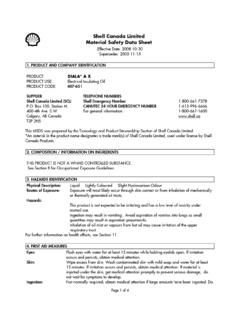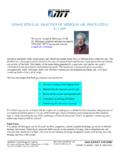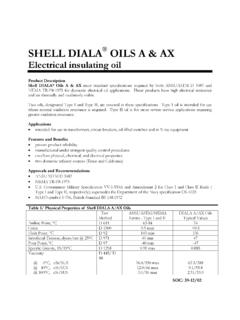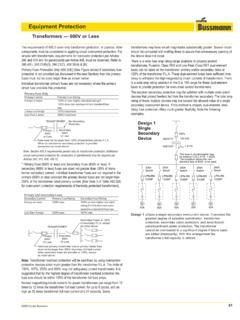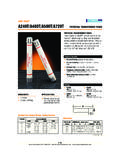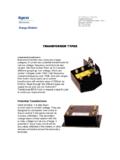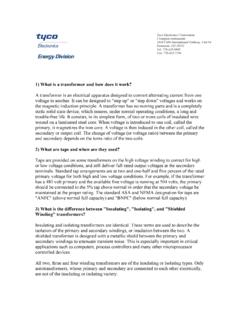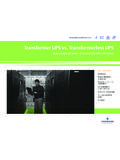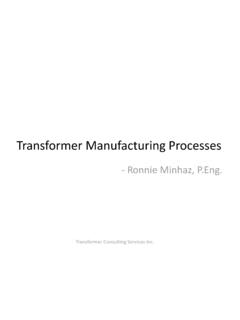Transcription of Transformer Options For Fire Sensitive Locations
1 Transformer Options For fire Sensitive LocationsTypeAdvantagesDisadvantagesBULL ETIN 92005 June, 2001(Supersedes March, 1999)Page 1 of 8I. Oil Low Transformer Lower Viscosity at Low Temperatures Requires Vault per NEC Article 450-C(Indoor) Liquid Dielectric Performance Higher Installation Cost Low Maintenance Cost Relatively Low fire Point Biodegradable/Low Toxicity Fluid Not Favored by Insurance Companies Preventative Maintenance (DGA) perIEEE Containment with Absorption Bed May BeRequired Loadbreak Operations Long Service Life Expectancy Deluge Extinguishing System May BeRequired Longest Clearance Distances Typically Self-Healing Under TemporaryDielectric & Thermal Overstress Excessive Minimum Clearance Distance Easy to Reprocess/DisposeMay Be Required (Outdoor) Pour Point < -35 C fire Barriers May Be Required (Outdoor) Not Classified as Edible Oil Non-Renewable Resource Liquids Higher Viscosity at Low Flawless Safety Record SinceIntroduction (1975)
2 Liquid Containment Means Required per Excellent Loadbreak PerformanceNEC 450-23 (Indoor)(R-Temp Fluid) Excellent Dielectric Properties Higher Cost than Conventional Mineral Oil Field Proven Through 550 kV BIL 3% Mineral Oil Contamination Reduces BiodegradableFire Point < 300 C Widest OEM Acceptance Not Classified as an Edible Oil Low UL fire Hazard Value (4-5) Pour Point 21 C Essentially Non-Toxic to Humans Excellent Compatibility Not Listed as Hazardous Waste Easy to Reprocess/Dispose Good Stability/Essentially Non-Sludging UL Classified - Bayonet with CL FusesAllowed FM Approved UL Classified Lower CostCOOPER POWER SYSTEMSD ielectric Fluids Products1900 East North StreetWaukesha, WI 53188-3899800 643-4335.
3 FAX 262 524-4654 Transformer Options For fire Sensitive LocationsTypeAdvantagesDisadvantagesBULL ETIN 92005 June, 2001(Supersedes March, 1999)Page 2 of Low Maintenance Cost Available in Listed TransformersHydrocarbons (cont d) Excellent Very High TemperatureStability (Aramid Paper Aging TestPassed at 250 C, 4000 Hours) Preventative Maintenance (DGA) perIEEE NEC Recognition Since 1977 NESC Safeguard Recognition Since1993 Listed Transformer Option Available Long Service Life Expectancy Typically Self-Healing Under TemporaryDielectric & Thermal Overstress Fully Miscible with ConventionalTransformer Oil, Natural and SyntheticEsters and Most Askarel Substitutes Higher Cost than Mineral Oil Flawless Safety Record SinceIntroduction (1997) Liquid Containment Means Required Time to Kraft Paper End-of-LifeImprovement 5-8 TimesPer NEC 450-23 (Indoor) Some Material Incompatibilities ( Ester(Envirotemp FR3 Fluid))
4 Excellent Dielectric PropertiesPVCs) Excellent Clarity Pour Point 21 C Rapidly and Completely Biodegrades Low Viscosity Best Lubricity Non-Toxic Generally Good Compatibility Not Listed Hazardous Waste Essentially Non-Sludging Low Maintenance Cost Preventative Maintenance (DGA) Food Grade Ingredients Renewable Resource Based Low UL fire Hazard Value (4-5) Transformer Options For fire Sensitive LocationsTypeAdvantagesDisadvantagesBULL ETIN 92005 June, 2001(Supersedes March, 1999)Page 3 of Ester (cont d) Ease to Reprocess/Dispose Good Stability UL Classified Bayonet with CL FusesAllowed FM Approved UL Classified NEC & NESC Safeguard Recognition Listed Transformer Option Available Long Service Life Expectance Typically Self-Healing Under TemporaryDielectric & Thermal Overstress Complies with Edible Oil Act Fully Miscible with ConventionalTransformer Oil, High Molecular WeightHydrocarbons and Most Askare lSubstitutes High Ester(Envirotemp 200 Fluid) Flawless Safety Record SinceIntroduction (1984)
5 Liquid Containment Means Required per Excellent Loadbreak PerformanceNEC 450-23 (Indoor) Excellent Dielectric Properties Some Material Incompatibilities (Certain Essentially Non-ToxicPVCs) Rapidly Biodegrades Not Listed by UL or FM Lowest Viscosity of Less-FlammableFluids Best Lubricity Generally Good Compatibility Not Listed Hazardous Waste Essentially Non-Sludging Low Maintenance Cost Preventative Maintenance (DGA) Long Service Life Expectancy Typically Self-Healing Under TemporaryDielectric & Thermal Overstress NESC Safeguard Recognition Since Very Low Pour Point (-55 C) Transformer Options For fire Sensitive LocationsTypeAdvantagesDisadvantagesBULL ETIN 92005 June, 2001(Supersedes March, 1999)Page 4 of Overall Good fire Safety Record Non-Biodegradable(Dienthylsiloxane) Lowest Viscosity at Low Temperatures Persistence potential in Environment Very Low Pour Point Produces Hazardous By-Product Excellent Stability (<150 C) Excellent ClarityParticulates When Combusted (Oxides ofSilicon, 80% of Liquid Weight) NEC Recognition Since 1977 NESC Safeguard Recognition Since1993 Higher Viscosity at Nominal OperatingTemperatures Low UL fire Hazard Value (4-5)
6 FM Approved Material Non-Compatible (Silicone &Standard Gaskets, Petrolatum, etc) UL Classified Wide OEM Acceptance Not Compatible with Most LoadbreakOperations Poor Lubricity Silicone Contamination (ppm) Can CauseConventional Oil Foaming Under Vacuum Special Concern for Paint LineContamination Very High Cost Disposal Difficulties & High Cost UL Classification Doesn t Allow BayonetFuses in Silicone Containment Means Required Indoor Adjudicated Liability on Adverse HealthEffects of Silicone Implants Non-Self Healing Under TemporaryDielectric & Heat Overstress (Can FormSemi-Conductive Bridging)
7 DGA Per IEEE Not Applicable Not Miscible with ConventionalTransformer Oil, Natural or SyntheticEsters, or High Molecular WeightHydrocarbonsTransformer Options For fire Sensitive LocationsTypeAdvantagesDisadvantagesBULL ETIN 92005 June, 2001(Supersedes March, 1999)Page 5 of Hydrocarbons(Polyalpha Olefins) Excellent Dielectric Properties High Cost Good Low Temperature Viscosity Limited OEM End-Users Excellent Lubricity Essentially Non-Toxic Biodegradable Typically Self-Healing Under
8 TemporaryDielectric & Thermal No fire Point Used for Retrofilling PCB transformers No Longer Offered in NewTransformers in (Interim and Permanent) FM Approved Hazardous Material Suspected Carcinogen UL Classified Listed Carcinogen, State of California Low Viscosity Limited Equipment Manufacturers Banned for Transformer Applications byUS Corps of Engineers & Others Extreme Concern for ThermalDecomposition By-Products, HCL,Trace Dioxin, Phosgene Severe Environmental Restrictions inNEC (Section 450-24) EPA Listed Hazardous Air No fire Point Used in Retrofilling PCB transformers No Longer Offered in NewTransformers(Interim) Low Viscosity Hazardous Material Suspected Carcinogen Limited OEM Acceptance Extreme Concern for ThermalDecomposition By-Products, (Dioxin) Severe Environmental Restrictions inNEC (Section 450-24) EPA Listed Hazardous Air PollutantTransformer Options For fire Sensitive LocationsTypeAdvantagesDisadvantagesBULL ETIN 92005 June, 2001(Supersedes March, 1999)Page 6 of No fire Point Low Viscosity No Longer Offered in NewTransformers Chlorofluorocarbon (CFC)
9 Based Tied to Ozone Depletion Future Availability Uncertain Leaks Can Go Undetected Special Maintenance Concerns Unusual Physical Dimensions Severe Environmental Restrictions inNEC (Section 450-24) No fire Hexafluoride (SF6) Ease of Code Compliance No Liquid Containment Needed Extreme Concern for Arcing ThermalDecomposition By-Products ( S2F10) Most Potent Green House Gas Evaluated Excellent Dielectric Withstandby EPA Environmental Persistence Measured inTens of Thousands of Years Larger Footprint Poor Cooling Medium High Cost of Special Transformer Design Higher Noise Level Susceptibility to Harmonic Currents DGA not Available Heat Output Stresses HVAC Lower Standard Overload Capacity Escallating Pricing Odorless, Oxygen Displacing Gas Typically Requires Remote HeatExchangerTransformer Options For fire Sensitive LocationsTypeAdvantagesDisadvantagesBULL ETIN 92005 June, 2001(Supersedes March, 1999)
10 Page 7 of Dry Low First Cost Subject to Contamination Many Manufacturers Higher Standard Energy Losses Ease of Code Compliance Require Periodic Cleaning No Liquid Containment Needed Reported Fires Higher Noise Level Lower Standard BIL Levels High Enclosure Temperature Standard Enclosure Does Not Pass WireProbe & Pry Test (ANSI/IEEE ) Special Outdoor Enclosure Affects LoadCapacity & Increases Cost Greater Susceptibility to HarmonicOverheating Lower Standard Overload Capability BIL
